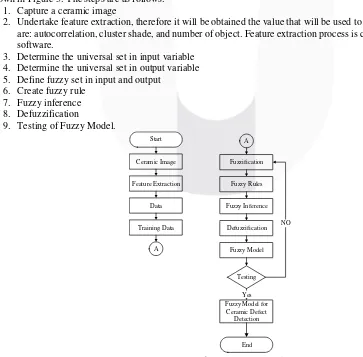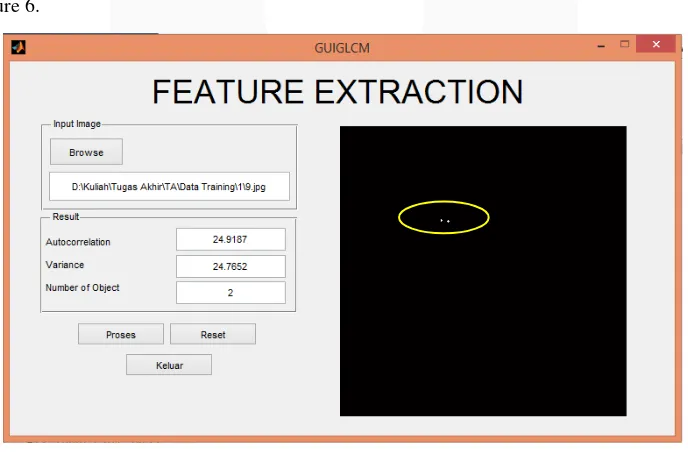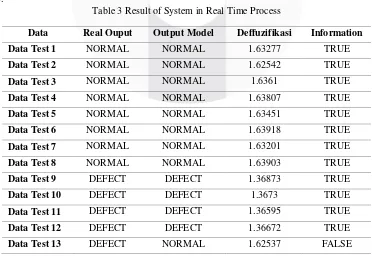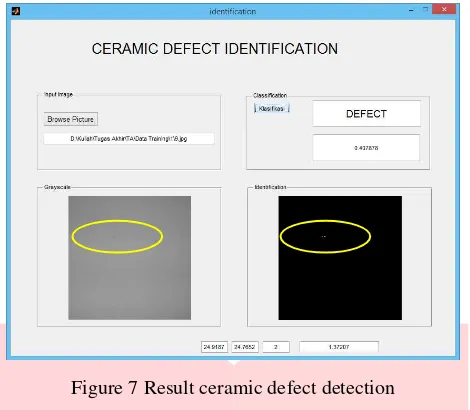DESIGN OF AUTOMATION SYSTEM FOR CERAMIC SURFACE QUALITY
CONTROL USING FUZZY LOGIC METHOD AT BALAI BESAR KERAMIK (BBK)
Anggie Prahas Putri1, Haris Rachmat2, Denny Sukma Eka Atmaja3
1,2,3Prodi S1 Teknik Industri, Fakultas Rekayasa Industri, Universitas Telkom
1[email protected], 2[email protected], 3[email protected]
Abstract
Indonesia is the world's top 10 ceramic users. To obtain best quality need to consider process of quality control, in SNI ISO 13006: 2010 there are six variables characteristic requirements related to quality of ceramic tiles. Currently the process of ceramic quality inspection in Indonesia, particularly in the Balai Besar Keramik is still done manually by human vision. Therefore, it is necessary to design a visual inspection system for digital image processing of ceramic automation using Fuzzy Logic method. Fuzzy model is one method that can be used to determine ceramic surface quality control. This study aims to apply fuzzy model in design of automation system for ceramic surface quality control and describes its accuracy rate and automatic database. To perform feature extraction using GLCM extraction method to obtain autocorrelation, sum of square (variance), and number of object. The information is used as input for data processing using fuzzy model in the identification of quality of ceramic surface defect. This research uses 13 real time test data which can produce the accuracy of automatic ceramic quality identification 92.31%.
Keywords : Automated Ceramic Surface Quality Control, Ceramic Defect Detection, Image Processing, Fuzzy Logic Model
1. Introduction
1.1 Research Background
Ceramic is the most popular type of media used in Indonesia because there are various advantages possessed, and also available for high usage and can be applied to almost all parts of the house. In addition to strong, ceramic house also does not require polishing and easy to maintain. Based on Table I.1 can be seen from the export side, the export volume growth has fluctuated. The export volume of ceramics in 2013 to 2014 has increased by 4.3%, and in 2014. On the import side, the growth of ceramic import volume always increases every year. The rate of import increase of 8.6%, and in 2014 to increase by 1%. Factors that cause import volumes to be higher than export volumes are that ASAKI coach is the government's very easy to include imported products without any more in-depth examination of standards, and in terms of price the difference is also cheaper than the price of ceramics in Indonesia [4].
Table 1 Volume Ekspor dan Impor Keramik [2]
Tahun 2013 2014 2015
Volume Ekspor (Ton) 295,780 337,000 336,520
Volume Impor (Ton) 733,510 966,000 991,910
To fulfill the demand for export and import on ceramic products required quality products that can compete with other companies. Quality is the overall nature of a product or service that has an effect on its ability to satisfy the stated or implied needs [5]. To obtain the best quality of a product needs to consider their quality control process. In SNI ISO 13006: 2010 there are six variable characteristic requirements related to the quality of ceramic tiles, namely: length and width, thickness, starightness of side, rectangularity, surface flatness and surface quality [1].
Currently the process of ceramic quality inspection in Indonesia, particularly in the Balai Besar Keramik is still done manually by human vision. Process of ceramic quality inspection manually will cause fatigue and saturation because process performed repeatedly. There are five groups causes of fatigue, namely monotonous work, load and duration work both physically and mentally, work environment, psychological, and disease [8].
1.2 Problem Definition
Problem definition from this research are:
1. How to design of automation system for ceramic surface quality control using Fuzzy Logic method? 2. How to measure the accuracy rate in process quality control of ceramic surface?
1.3 Research Objectives
The objectives of this research are:
1. To design of automation system for ceramic surface control quality using Fuzzy Logic method. 2. To measure the accuracy rate in process quality control of ceramic surface.
2. Literature Review
2.1 Automation System
The automated system consists of three basic elements (1) power to achieve the process and operate the system, (2) the instruction program to direct the process, and (3) the control system to drive the instruction. The relationship between these elements is illustrated in Figure 1. All qualified systems as automated include the three basic elements in one form or another [3].
Power
Process Control System
Program of Instructions
Figure 1 The basic elements of automation systems [3]
The basic element of automation systems consist of
1. Power
Power is basic element which is required and used to operate some process and drive all of the component in the automation system.
2. Program of Instruction
Program of instruction is element required to operate control of the process from list of program and used to direct the operational of automated system.
3. Control System
Control system is an element to execute program of instruction and to accomplish the process from each automation elements.
2.2 Gray-Level Co-occurence Matrix (GLCM)
Gray Level Co-occurrence Matrix (GLCM) is a technique for obtaining image textures using second order calculations. First-order texture measurements using statistical calculations are based on pure image values only, such as variance, and do not pay attention to the neighboring pixels [6].
2.3 Fuzzy Logic
Fuzzy logic is a methodology of problem-solving control systems, suitable for implementation on systems, from simple systems, small systems, embedded systems, PC networks, multichannel or workstations based data acquisition and control systems [10].
Fuzzification Fuzzy Inference Deffuzification Rule Based
Input Output
There are several operational stages which include, among others:
1. Fuzzification
Fuzzification is defined as a mapping of real values point x*∈ U ∁ Rn to fuzzy set A’ in U. It can be said
that fuzzification is the process crisp value into fuzzy value by using membership function [7].
2. Fuzzy Inference
Fuzzy inference is the process of implication in the reasoning of the input value in order to determine the output value as a form of decision-making. One of the most commonly used reasoning models is max-min reasoning. In this reasoning, first process is to perform the min signal operation of the fuzzified output output, which is continued by max operation to find the output value which will be furtherefefined as output [7].
3. Rule Based
The rule based on fuzzy logic control is a form of "If-Then" or if-then relation rule as follows: If x is A then y is B
Where A and B are linguistic values defined in the range of variables X and Y. The statement "x is A" is called antecedent or premise. The statement "y is B" is called consequent or conclusion [9].
4. Defuzzification
Defuzzification is defined as a mapping from fuzzy set B’ in V ∁ R to crisp point 𝑦*∈ V. It can be interpreted defuzzification is a transformation process that states the change of form of the fuzzy set resulting from fuzzy inference to its crisp value based on a defined membership function. The value of defuzzification is the output of the fuzzy logic process [9].
3. Discussion 3.1 Fuzzy Logic Model
Data analysis is performed to identify ceramic defect using Fuzzy Model. fuzzy model is described in the diagram shown in Figure 3. The steps are as follows.
1. Capture a ceramic image
2. Undertake feature extraction, therefore it will be obtained the value that will be used to Fuzzy Model, these are: autocorrelation, cluster shade, and number of object. Feature extraction process is conduct with Matlab software.
3. Determine the universal set in input variable 4. Determine the universal set in output variable 5. Define fuzzy set in input and output
6. Create fuzzy rule
In this research, first step the ceramic defect identification capture digital ceramic images by image acquisition (light intensity 300 lx, 1.3 megapixels, and 50 cm camerea distances). Crop image so only ceramic image are detected, as shown in Figure 4.
(a) (b)
Figure 4 Original defect ceramic (a) and crop ceramic (b)
Convert RGB (Red Green Blue) to grayscale image and convert grayscale into binary image, where white is defect, as shown in Figure 5.
(a) (b)
Figure 5 Grayscale Image (a) and Binary Image (b)
Second step, then calculates autocorrelation, sum of square (variance) and number of objcet using interface, as shown in Figure 6.
Figure 6 Result extraction features
The universal set is value that allowed to be operated in a fuzzy variable. In other words, universal set is a range of minimum to a maximum value of all sample data. Based on data obtained from the feature extraction then the universal sets of each image as follows:
1. Autocorrelation
The universal set for autocorrelation from the training data of feature extraction is minimum 24.1814 and maximum 34.2239. Then the universal set for number of object is UA = [24.1814 34.2239].
2. Sum of Square (Variance)
The universal set for sum of square (variance) from the training data of feature extraction is minimum 24,0395 and maximum 34,0558. Then the universal set for number of object is UB = [24.0395 34.0558]. 3. Number of Object
The universal set for number of object from the training data of feature extraction is minimum 0 and maximum 4. Then the universal set for number of object is UC = [0 4].
This result as an input set of the fuzzy logic. In this research, applied fuzzy uses Mamdani model. Using membership function to definition group fuzzy set shown in Tabel 2
Table 2 Result from extraction feature
Data Result of Extraction Membership Function Fuzzy Set
Autocorrelation 24,9187 0,5873 A2
Sum of Square (Variance) 24,7652 0,5796 B2
Number of Object 2 1 C5
Kondisi Keramik Defect Defect VDefect
Based on Tabel 2 then the rules are from the extraction is:
“IF autocorrelation is A2 AND variance is B2 AND number of object is C5 THEN Kondisi Keramik is VDefect”
Input variable as antecedent and output variable as consequent. If there is a same antecedent but the consequent is different, then optimization rules is needed. The determination of optimization rules is by choosing multiply of the largest value of membership degree. This research use 729 rules.
3.2 Defect Detection
For validating the result for the fuzzy model, image used as an input in this system is test data using 13 samples of ceramic imagess consisting of 8 normal ceramic images and 5 defects ceramic images. Testing the model shown in Table 3.
Table 3 Result of System in Real Time Process
Data Real Ouput Output Model Deffuzifikasi Information
Data Test 1 NORMAL NORMAL 1.63277 TRUE
Data Test 2 NORMAL NORMAL 1.62542 TRUE
Data Test 3 NORMAL NORMAL 1.6361 TRUE
Data Test 4 NORMAL NORMAL 1.63807 TRUE
Data Test 5 NORMAL NORMAL 1.63451 TRUE
Data Test 6 NORMAL NORMAL 1.63918 TRUE
Data Test 7 NORMAL NORMAL 1.63201 TRUE
Data Test 8 NORMAL NORMAL 1.63903 TRUE
Data Test 9 DEFECT DEFECT 1.36873 TRUE
Data Test 10 DEFECT DEFECT 1.3673 TRUE
Data Test 11 DEFECT DEFECT 1.36595 TRUE
Data Test 12 DEFECT DEFECT 1.36672 TRUE
As shown in Figure 7.
Figure 7 Result ceramic defect detection
This result is determined from deffuzification values for normal ≥ 1.5 and deffuzification values for defects < 1.5. To determine the accuracy of this training data, use the following formula:
Accuracy Rate = Total Data TrainingNumber of True x100%
Accuracy Rate = 1213x100%
Accuracy Rate = 92.31%
Therefore, the accuracy rate used Fuzzy Model with triangle representation of membership function, Mamdani of Fuzzy Inference, centroid of defuzzification, and 729 rules the obtained accuracy rate 92.31%.
4. Conclusion
Automatic ceramic surface inspection using fuzzy logic with GLCM extraction to get autocorrelation, sum of square (variance), and number of object is proposed. Thus the proposed ceramic inspection using fuzzy logic implemented with MATLAB provides better result in identifying ceramic defect. The above proposed system obtained an overall accuracy rate 92.31% of by considering three variable feature extraction.
Daftar Pustaka:
[1] Atmaja, D. S. E., 2015, Optimasi Pengukuran Dimensi & Cacat Permukaan Ubin Keramik Menggunakan Pengolahan Citra Digital dan Full Factorial Design, Tesis. Yogyakarta: Fakultas Teknik, Universitas Gadjah Mada.
[2] Bank Sentral Republik Indonesia, 2016, Volume Ekspor dan Impor Keramik, [Online] Available at: http://www.bi.go.id/id/statistik/seki/terkini/eksternal/Contents/Default.aspx, [Accessed 14 November 2016]
[3] Groover, M.P. 2001. Otomasi, Sistem Produksi dan Computer Integrated Manufacturing. New Jersey:Pearson.
[4] Kanal Satu, 2016, Gas Masih Mahal, Industri Keramik dan Granit Indonesia Lesu, [Online] Available at: http://kanalsatu.com/id/post/49944, [Accessed 14 November 2016]
[5] Kotler, Philip. 2005. Manajamen Pemasaran, Jilid 1 dan 2. Jakarta: PT. Indeks Kelompok Gramedia. [6] Kadir, Abdul dan Susanto, Adhi.. 2013. Teori dan Aplikasi Pengolahan Citra. Penerbit Andi: Yogyakarta. [7] Mulato, F. Y., 2014. Klasifikasi Kematangan Buah Jambu Biji Merah (Psidium Guajava) dengan
Menggunakan Model Fuzzy. In: SKRIPSI. Yogyakarta: Universitas Negeri Yogyakarta, p. 3.
[8] Muizzudin, Ahmad, 2013, Hubungan Antara Kelelahan Kerja Dengan Produktivitas Kerja Pada Tenaga Kerja Bagian Tenun Di PT. Alkatex Tegal, Skripsi. Semarang: Universitas Negeri Semarang.
[9] Sari, Nur Endah., 2011, Prediksi Cuaca Berbasis Logika Fuzzy Untuk Rekomendasi Penerbangan di Bandar Udara Raja Haji Fisabilillah. Jakarta: Universitas Gunadarma.
![Figure 2 Fuzzy Logic Chart Block [9]](https://thumb-ap.123doks.com/thumbv2/123dok/3026658.1715014/2.595.86.524.291.551/figure-fuzzy-logic-chart-block.webp)



